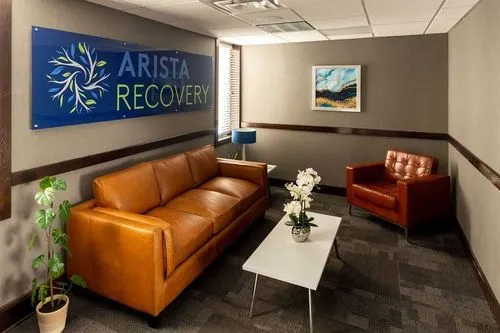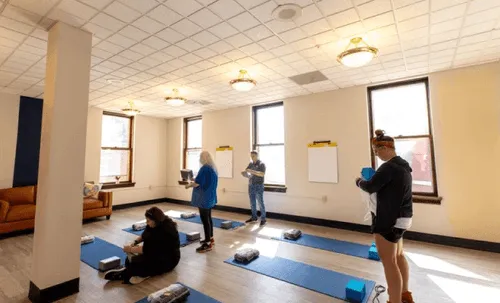OPIOID REHAB CENTER IN KANSAS
.webp)
What are Opiates & Opioids?
Opiates
An opiate is a natural substance that is extracted from the opium poppy plant, which is where other substances originate, including heroin, morphine, and codeine.
Opiates are not considered safe simply just because they are natural. They are highly addictive and overdose and dependency are common among users.
Opioids
When individuals refer to opioids, they are essentially speaking of the broad category of any type of natural or man-made substance that binds to opioid receptors in the brain. Opioids are synthetic and are chemically created.
The CDC defines opioids as natural, synthetic, or semi-synthetic chemicals that interact with opioid receptors on nerve cells in the body and brain, and reduce the intensity of pain signals and feelings of pain.
Opioids contain substances that are used to make opiates; they are synthetic and semi-synthetic substances, such as fentanyl and hydrocodone.
Opioid addiction is no joke. These substances are being highly abused in the United States and the abuse of opioids has been officially categorized as an epidemic.
All opiates are opioids, but not all opioids are opiates.
Common Opioids & Opiates
Nearly 500,000 people have died from an overdose involving opioids, including prescription and illicit opioids, between the years 1999 to 2019 (CDC).
There are multiple types of opioids circulating around at any given time.
Opioids include natural substances are codeine, morphine, and heroin, while fentanyl and methadone are categorized as synthetic substances, and examples of semi-synthetic substances are hydrocodone (Vicodin) and oxycodone (Oxycontin).
Each of these can easily result in opioid addiction and dependence.
What Do Opiates Look Like?
Opiates can come in various forms, especially depending on whether the substance is prescribed or illegal. They can be ingested in tablet, capsule, or syrup form and can also be used as a suppository. Opium and heroin more specifically, come in a dark or white powder.
How Addiction Happens
Those who become addicted to opiates don’t do so on purpose. Epigenetics along with other factors play a role in who becomes addicted and also answers the questions of how and why.
Epigenetics is the study of how your behaviors and environment can cause changes that affect the way your genes work. Unlike genetic changes, epigenetic changes are reversible and do not change your DNA sequence, but they can change how your body reads a DNA sequence, (CDC).
Opiate addiction will not necessarily happen to anyone who uses it; however, it is highly likely due to its chemical makeup. Someone who has a biological predisposition to drug abuse and is affected by certain environmental factors can easily become addicted.
Common Signs of Opioid Misuse
Due to its highly addictive nature, misuse of these substances can turn into an opioid medication addiction or an addiction to the illegal forms of the substance.
These are typical signs that someone is abusing opioids:
- Frequently finishing prescriptions early
- Taking more medication than prescribed
- Changes in daily habits
- Changes in personality or mood
- Acting against morals and values
- Visiting multiple doctors to obtain prescriptions
- Isolating from loved ones
- Regularly having mood swings
- Showing signs of intoxication
And the list can go on and on. Those who are misusing opioids are encouraged to attend opioid addiction treatment.
Effects of Opioid Addiction
Short-Term Effects
The short and long-term effects of opioid misuse can be devastating. Physical health and wellness, as well as mental health, are all negatively affected by the misuse of opioids.
The negative impact that opioids have on an individual is as follows…
- Dry mouth
- Constipation
- Feeling lightheaded
- Feeling euphoric and overly elated
- Constricted pupils
- Lack of coordination
- Sleeping too much
- Nausea and vomiting
- Confusion
- Loss of appetite
- Irritability
- Mood swings
Long-term health effects are much more severe and can include death.
Long-Term Risks & Effects
The reported long-term opioid and opiate use effects included:
- A weakened immune system
- Gastrointestinal issues, such as constipation and bowel obstruction
- Respiratory depression
- Bloodborne infections and illnesses
- Vein collapse
- Coma
- Skin abscesses
- Sexual dysfunction/impotence
- Brain damage and loss of cognitive abilities
- Dental problems
Many people do not realize that abusing even prescription medication can have such destructive effects. Opioids can, unfortunately, cause severe long-term health problems.
Factors Associated with Opioid Addiction
As stated above, both genetics and environmental factors play a role in whether or not an individual will become addicted after experimenting with a substance. Also, someone may dabble here and there with opioids and not become addicted until the perfect storm comes through and their addition gene is triggered by biological or environmental factors.
Common environmental factors that are associated with misuse can include being around substance abuse at a young age, childhood trauma, trying substances at an early age, parental involvement, socioeconomic factors, access to substances, etc.
Opioid Overdoses
In the United States, over 81,000 drug overdose deaths occurred the 12 months ending in May 2020, the highest number of overdose deaths ever recorded in a 12-month period. More specifically, in 2019, deaths involving prescription opioids rose to over 14,000. And every single day, over 100 people die of an opioid-related overdose in the United States.
These stats are staggering and it is no wonder that opioid drug use has become a serious epidemic.
It is fairly easy to overdose on opioids, especially if the user is mixing it with other substances or is taking too much due to increased tolerance.
The following are signs of an opioid overdose:
- Unresponsive to outside stimulus
- Awake, but unable to talk
- Breathing is very slow and shallow, erratic, or has stopped
- For lighter-skinned people, the skin tone turns bluish purple, for darker-skinned people, it turns grayish or ashen.
- Choking sounds, or a snore-like gurgling noise (sometimes called the “death rattle”)
- Vomiting
- The body is very limp
- The face is very pale or clammy
- Fingernails and lips turn blue or purplish black
- Pulse (heartbeat) is slow, erratic, or not there at all
If a user is around someone else while overdosing, they have a much better chance of living.
Diagnosing Opioid Addiction
The first step in diagnosing opioid misuse is being knowledgeable about the signs of use and abuse. Early intervention is key.
The DSM-5 has specific criteria for diagnosing an opioid use disorder. A licensed professional such as a psychiatrist must be the one to officially diagnose.
Three examples of criteria include:
Opioids are often taken in larger amounts or over a longer period of time than intended.
There is a persistent desire or unsuccessful efforts to cut down or control opioid use.
Important social, occupational, or recreational activities are given up or reduced because of opioid use.
If you or someone you know is abusing this substance, encouraging opioid addiction help is important.
What We Do
Treatment Programs at Arista
Make the Call That Will Change Your Life.
Speak to one of our caring intake coordinators 24 hours a day, 7 days a week.

Commonly Asked Questions
What is opioid addiction?
Opioids are highly abused in the United States; someone who cannot control their use of opioids becomes officially an addict. Opioid use disorder is a diagnostic category from the DSM-5.
What causes an opioid addiction?
Opioid addiction can be caused by a combination of biological and environmental factors.
How does one fight opioid addiction?
Attending inpatient treatment to detox from opioids and begin an addiction treatment program are the first steps in fighting opioid addiction.
Is opioid addiction a disease?
Yes, just like substance abuse is a disease, opioid addiction is a disease.
What is the best treatment for opioid addiction in Kansas?
Inpatient treatment with a detox program then stepping down to an outpatient program along with aftercare is the recommended treatment for opioid addiction.
What is the opioid addiction epidemic?
High rates of opioid abuse and overdose, including death, are creating an epidemic—or a crisis that has become out of control.
What does opioid addiction look like?
There are various symptoms and signs to look for in someone who is addicted to opioids. There are many physical, mental, and emotional symptoms.
How to help someone with an opioid addiction?
Loved ones who know someone with opioid addiction need to be supportive, encourage treatment, and attend NA meetings.
Our Unique Therapies
Explore our innovative approach to addiction treatment at Arista Recovery. From evidence-based therapies to holistic and experiential methods, we offer an immersive experience that works to treat the root causes of substance abuse our full continuum treatment programs












Educational Therapy
Explore Educational Therapy at Arista Recovery and how it can help you recover.
Cognitive Behavioral Therapy (CBT)
Explore cognitive behavioral therapy at Arista Recovery and how it can help you recover.
Dialectical Behavioral Therapy (DBT)
Explore dialectical behavioral therapy for addiction treatment and how it can help you recover.
Horticultural Therapy
Explore horticultural therapy at Arista Recovery and how it can help you recover.
Sand Tray Therapy
Explore sand tray therapy at Arista Recovery and how it can help you recover.
Experiential Therapy
Explore experiential therapy at Arista Recovery and how it can help you recover.
Synergistic Therapy Recovery Program
Our Synergistic Recovery Program programs in Kansas City provides effective training, both in the physical and mental domains.
We're proud to accept most insurances
Most major insurance plans can help cover up to 100% of the cost of treatment at Arista Recovery. Fill out our free insurance benefits form now and get started on your journey to long-term healing. You deserve it.










GET HELP FOR OPIOID ADDICTION
Opioid Addiction Treatment in Kansas
Opiate and opioid addiction treatment centers are all around the United States, as they are much needed.
A common treatment for opioid addiction is medication-assistant treatment (MAT) in an inpatient program. There are opioid clinics as well where patients are given methadone or another prescribed drug to help with the detox process and lessen the challenging withdrawal symptoms.
Treatment should take place under the supervision of licensed medical staff who are trained specifically in this area.
The best treatment for opioid addiction is going through inpatient and outpatient programs, as well as following up with aftercare.













